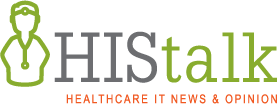Readers Write: The Next Frontier for Healthcare Consumerization
The Next Frontier for Healthcare Consumerization
By Aaron Fulner
Aaron Fulner, MS is senior director of product marketing at Edifecs of Bellevue, WA.

The pandemic accelerated consumers’ move to the driver’s seat of their healthcare. Consumers are using digital health devices now more than ever and are demanding a personalized, on-demand healthcare experience. To meet these heightened expectations, the healthcare industry needs to better stitch together all of the pieces – telehealth, artificial intelligence (AI) and machine learning, and interoperability standards – to create a comprehensive delivery model. A model, where data can be exchanged quickly and accurately. This is the next frontier for the consumer healthcare movement.
To reach this next stage, the healthcare industry needs to ensure data can be shared seamlessly across the healthcare system to best equip providers with real-time health information. Here’s how we get there:
Expand Telehealth from Acute Care to Chronic Condition Management
It’s no secret that telehealth use skyrocketed during the pandemic. Even following its peak in 2020 and 2021, telehealth usage is still 38 times higher than prior to the pandemic. Patient and provider muscle memory is changing, and telehealth is now the go-to for urgent care needs. The next chapter of the telehealth story includes a movement from tele-urgent care to telehealth for chronic care management and preventative care. This is especially important as 40% of adults in the U.S. reported avoiding medical care due to the pandemic. This means providers are playing catch up to ensure patients’ routine and preventative care needs are met.
Additionally, as providers work to offer comprehensive care to patients, they must have access to rich datasets about each patient. This includes using administrative information from encounter and enrollment files as well as clinical data stored in electronic medical records. A comprehensive view of a patient enables the provider to be an informed partner in the care of a patient.
Integrate Artificial Intelligence and Machine Learning into the Internet of Things
Beyond telehealth, consumers are embracing the Internet of Things (IoT) to monitor their health at home. These digital health devices – smart watches, exercise bikes, glucose monitors, etc. – are used by more consumers today than ever before. For example, a recent Rock Health analysis found that digital health wearable ownership increased from 13% of consumers surveyed in 2015 to 45% in 2021. The question remains: How can the industry enhance the impact of these tools with machine learning and artificial intelligence (AI)?
Remote monitoring devices combined with machine learning and AI create a powerful tool for providers by delivering real-time information and changes in patient health. For example, if a patient’s glucose is low, a glucose monitoring device with a layer of machine learning and AI proactively sends a notice to their provider to reach out and determine if a change in their care plan is appropriate. Ultimately, this gives providers the data to intervene earlier, work with more patients at a time, and improve margins.
Connect Consumer Digital Health Device Data with Provider Workflows
This increase in digital health tool utilization is ushering in a flood of new patient data. To move forward, the industry must integrate siloed data into provider workflows so providers can deliver holistic care. Connecting consumer health data with provider workflows signifies the convergence of healthcare and business data management standards.
To date, the Health Insurance Portability and Accountability Act (HIPAA) and recent interoperability rules declare the consumer as the agent of personal health data. Meanwhile, Health Level Seven International (HL7)’s Fast Healthcare Interoperability Resources (FHIR) and the Da Vinci Project have established the technical standardizations with consumer data and how it is exchanged across stakeholders.The Office of the National Coordinator for Health Information Technology (ONC) is leading the final push through its Trusted Exchange Framework and Common Agreement (TEFCA), which outlines business rules for data exchange and determines allowable uses for payment, reimbursement, and care data without consumers’ permission. The last mile for closing this gap between consumer data, payer, and provider workflows lies in empowering service providers to adopt these standards industry-wide.
The key to the future of healthcare consumerization is to determine how data is exchanged across the healthcare industry to better inform care, improve provider workflow, and integrate digital health data solutions into one place.


The ruling does seem to actually touch on things like UserWeb access "...the final rule applies to terms and conditions…